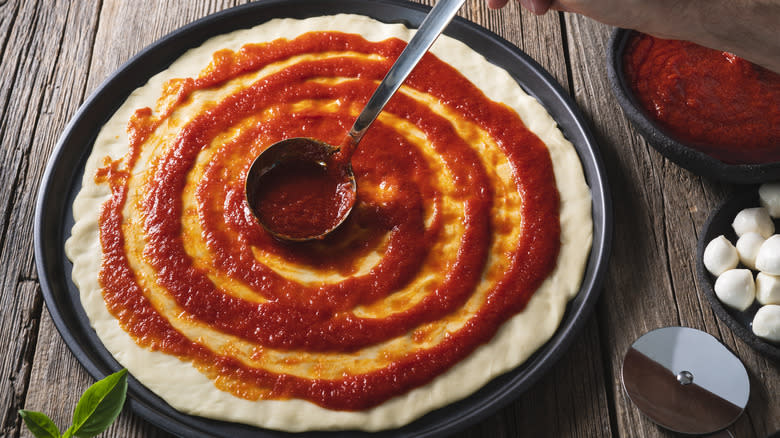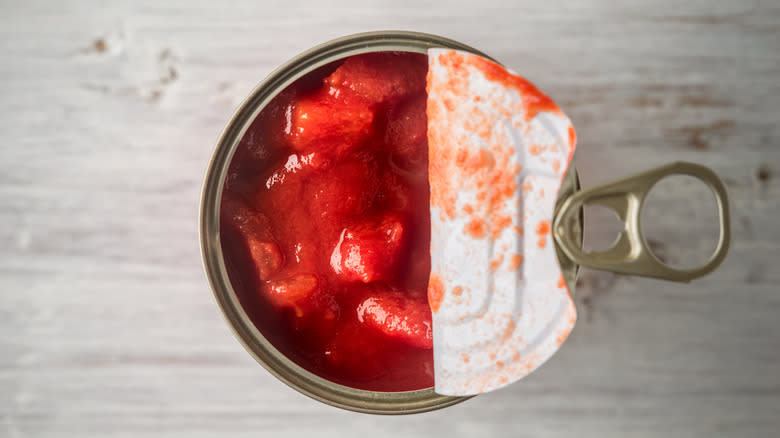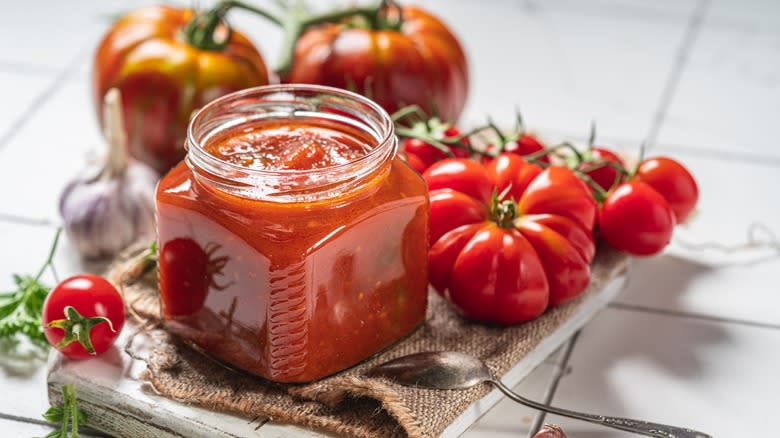Do Yourself A Favor And Stop Cooking Your Pizza Sauce

Chances are your kitchen does not have a wood-fired oven like your local pizzeria does. But that doesn't have to stop you from making pizza at home, and you likely have the tools to create a pie that beats any frozen pizza from the grocery store. Even the step of making the pizza sauce might be easier than you think: It's fairly simple to whip up a homemade sauce without having to cook anything (besides the pizza itself, of course). In fact, if you cook your pizza sauce you might just be making extra trouble for yourself and actually worsening the flavor of your pie.
You don't actually need to cook the sauce because it will eventually be cooked with the entire pizza, and pre-cooking it can take away from the tomatoes' vibrant flavor. Using raw ingredients allows every element of the sauce to be at its most flavorful. This is part of what separates pasta sauce and pizza sauce. Because pasta sauce is not twice-cooked, making it often involves simmering the tomatoes with onions, garlic, and herbs before combining them with the pasta of choice. Pizza sauce, however, frequently uses uncooked crushed tomatoes, to make a sauce that is brighter and easier to spread across the dough. Otherwise, the sauces are similar, as both are mostly just tomatoes, garlic, and herbs: That's all you need for a good tomato sauce.
Read more: The 101 Best Pizzas In America
Tips For The Best Pizza Sauce

Since the reason you wouldn't pre-cook your sauce is to avoid diluting the flavor of the tomatoes, it's important that the tomatoes have a lot of flavor in the first place. This means that you should be using high-quality tomatoes. Canned whole real San Marzano tomatoes from Italy are the ideal choice, but not the only choice for a flavorful pizza sauce. If you can't find them you'll be glad to know that, increasingly, there are a variety of fresh-tasting canned tomatoes on the market.
Once you've got tomatoes, you're most of the way there. A traditional Neopolitan pizza sauce often calls for nothing more than uncooked tomatoes and a pinch of salt, but this base is endlessly customizable with herbs, spices, and alliums. Adding garlic is a must, and other herbs like basil, oregano, thyme, or even red pepper flakes can punch up your pizza sauce. Balsamic vinegar is the secret ingredient that can add a tangy sweetness to the sauce.
It's worth noting that some people do like making pizza with cooked sauce, particularly in the U.S., and New York-style pizza frequently has a heavily cooked sauce on a thin crust. But if you're going for something easier, fresher, and more traditional, then uncooked sauce will get you closer to that.
Canned Or Fresh?

Many people prefer to use good canned tomatoes rather than fresh for their homemade pizza sauce. Canned tomatoes are usually harvested while they're in season, they have the skins removed, and they often have salt added. That salt helps strengthen the tomato's flavor, so they still taste like they're in season any time of year. Fresh tomatoes require a little extra effort and unless they're in season they won't be as flavorful. However, you can't really beat a perfectly ripe summer tomato, and if you're lucky enough to have some on hand, you can whip up a sugo di pomodoro crudo, which is a simple uncooked sauce made with fresh tomatoes. At its simplest and freshest, don't make a sauce at all, just slice the fresh tomato and combine it with fresh mozzarella and fresh basil for a pizza inspired by a Caprese salad.
Alternatively, you might try upgrading your sauce game with tomato passata. Passata is similar to a tomato puree, and it uses sieved, uncooked very flavorful tomatoes. It's a little thin and if you add too much the dough might become soggy, but as with any canned or jarred tomatoes you use for pizza sauce, you can strain it to remove some of the excess liquid. It works well for pasta sauce or tomato soup, and it's a great alternative to canned tomatoes in a no-cook pizza sauce.
Read the original article on Daily Meal.

 Yahoo Finance
Yahoo Finance 